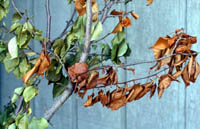Be Ready for Fire Blight | |
|---|---|
| April 30, 2008 | |
|
Fire blight was common in 2007, setting the stage for a problem this year. Stem cankers left from last year’s infection will provide the inoculum. Warm, wet conditions provide the ideal environment. Many landscape trees are common hosts. Know how to recognize and manage this disease. Fire blight is a bacterial disease that causes concern to growers with apples, pears, crabapples, and ornamental pears (yes, Callery pear). You might also see infection on other rosaceous hosts, such as cotoneaster, hawthorn, quince, firethorn, and mountain-ash. Fire blight is caused by a bacterium (Erwinia amylovora), and the bulk of the infection occurs during flowering when temperatures are warm (mean daily temperature of at least 60°F) and conditions are wet. The causal bacterium may spread by wind, water, equipment, and animals. Rain or insects may move the bacterium from cankers and bark to open blossoms, vigorous shoot tips, and leaves. As long as warm, wet conditions continue during bloom, the bacterium can continue to infect. Management practices focus on controlling the bacterium during flowering. Look for water-soaked or wilted new growth that quickly turns brown to black and remains attached to the stem, as in the image.  . .Also, dark cankers may develop in the wood, especially on edible and ornamental (Callery) pears. Generally, the affected foliage is at branch tip, with a distinct demarcation between affected and unaffected leaves. Because the bacterium originates on old cankers and bark infection, removal of branches killed by fire blight is extremely helpful in disease control. This should be done when the tree is dormant or when weather is hot and dry. Do not remove infected wood in the spring. Disinfecting pruning equipment is an important step is reducing disease spread. Use 10 percent household bleach or similar disinfectant between cuts. Cut out infected branches, going 6 to 8 inches into the good wood to be certain all infected tissue is removed. If you are thinking of planting new trees, do a bit of searching for resistant varieties. It will be well worth your search. Among the ornamental Callery pears, ‘Aristocrat’ and ‘Autumn Blaze’ have good resistance reports, although we find that sometimes cultivars get mixed reviews. Also refer to the University of Illinois Report on Plant Disease on fire blight at http://www.ag.uiuc.edu/~vista/horticul.htm. Pesticides may be used for fire blight prevention. A dormant (early-season) application of copper may be of benefit to kill bacteria as it oozes from cankers. Copper compounds are usually applied before green tip (when green leaf tips begin to emerge from buds). Copper products may include Camelot, Champion, Chipco Aliette, Junction, Kocide, Magellan, Nu-Cop, and Phyton 27. Antibiotics are used in commercial-fruit-production areas to prevent fire blight. Sprays are made during bloom, specifically when no more than 10 percent of the blooms are open on the tree. This year, southern Illinois fruit farms began fire blight sprays the week of April 17. Few antibiotics are available or recommended for ornamental plants. It is best to rely on nonchemical management practices to control fire blight on ornamental plants. A few other helpful management tips include avoiding high-nitrogen fertilizers, which promote lush susceptible growth; removing water sprouts when they are small; and removing nearby neglected pear and apple trees. | |
| Author: | Nancy Pataky |
